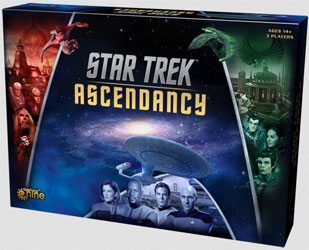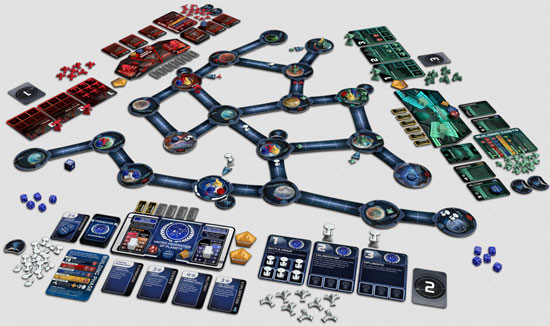



play board games
Board game reviews, strategy tips & session reports
Star Trek Ascendancy Review
 Stats:
Stats:
No. of players: 3
Amount of time to play: 180 min
Age requirements: 14+
Set-up time: 5-10 minutes
Star Trek Ascendancy is a 4X game full of space exploration and conflict in the Star Trek universe.
Star Trek Ascendancy Rules Description:
In Star Trek Ascendancy, you play as either the Federation, Klingons or Romulans. Each race has a unique ability and hindrance. You must gain five Ascendancy tokens or control all three home worlds to win.
At the beginning of this game, you build the board. As you warp from your home world to explore your surroundings, you place systems on space lanes. The position of space lanes can be placed anywhere around a planet. You can even move previously placed systems that are only connected to one space lane. This gives you a lot of flexibility when laying out the board and making connections.
When you explore a new system, you flip a card to determine its current inhabitants. Some systems are uninhabited and ready to be developed, others have existing civilizations on them and some might actually endanger your fleet. You can takeover inhabited systems through cultural hegemony or by attacking its inhabitants.
Once you control a planet, you may build nodes on it. The type and number of nodes differs for each system. Nodes get you production, research or culture tokens. You spend production to build any type of node and ships. You spend research tokens to build research nodes, upgrade your weapons and shields or develop new technologies. Culture tokens are used to build culture nodes and five culture tokens get you an Ascendancy token.
Soon you will make contact with the other players at which point you can make trade agreements with your opponents. Trade agreements get you production tokens each round and set up a tentative truce with your trading partner. If you enter a space without their permission or attack them, you must return their trade agreement.

Combat is straightforward. You roll as many dice as you have ships in the combat and you must meet or beat your to hit number which is based on how much you’ve developed your weapons. You subtract you opponent’s shield rating from your rolls and each die that still hits removes one ship. Combat is simultaneous so both players roll before you remove ships. Some research projects can help you gain first strike, make sixes always hit or other military bonuses.
Initiative is determined randomly until you have made contact with another player. At that point, those players may bid on turn order with the player going first the last round bidding first. Any players that have not made contact with anyone or bid nothing have their turn order determined randomly.
On your turn, you build structures and ships then you may execute command actions. You start with five command actions, but gain one for each star base you build. You can also get more from completing some research projects. After all players take their turn, you check for a winner. If no one has won, you gain income and continue playing the game.
Quick Review of Star Trek Ascendancy:
Star Trek Ascendancy is truly an epic game with lots of theme and some really unique and fun mechanics. I am not a Trekkie, but can appreciate the amount of care for the license that was put into this game.
The components for this game are fantastic. The little ships and nodes look great on the sprawling board. The player boards are unique and look great too. The rules might take a couple of read-throughs to really understand, but not because they are poorly written. There is a lot going on. A better index of specific rules could have helped too.
The way you explore and layout the board in Star Trek Ascendancy is great. It really feels like you are going where no man has gone before. Will you find a crisis, a virgin world or a developed civilization? You must also decide which way to build. Do you remain insular or head toward other players? The decisions matter and can really impact the game.
Each race is unique with their own bonuses, penalties and research projects. You will want to try them all. They feel like their counterparts from the Star Trek universe and add to the replay value of this game.
As I said above Star Trek Ascendancy is an epic game. And it is long. Since you need to react to other players, the downtime can be annoying (depending on your group). I need to try this with the shorter variations that are included. But at its current length I am not sure how often it will hit the table. Another factor that limits how often this game gets played is the requirement of exactly three players. I have heard this is fixed with expansions, but with just the base game you are limited.
If you are a fan of Star Trek you should give Ascendancy a try. It is long but has some interesting mechanics and lots of theme. The beginning of the game and the way you explore is especially satisfying.
Score and synopsis: (Click here for an explanation of these review categories.)
Strategy 4 out of 6
Luck 4 out of 6
Player Interaction 5 out of 6
Replay Value 5 out of 6
Complexity 4 out of 6
Fun 4 out of 6
Overall 4 out of 6


I’ve played this about 1/2 dozen times with the same group of friends. I didn’t feel like we really “got” all the rules until about the 3rd play through. But every time we played the game went faster. We expanded quicker, made our decisions sooner when our turn game around, and the game overall took less time.
That said, it is still EPIC in feel and length. Hours of game time, especially those first few games when people are still learning the rules & their options.
I can’t wait for the expansions to finally arrive so we have new options and new play styles. The Federation, Klingons, and Romulans can get a bit stall in strategy after a few games of each.